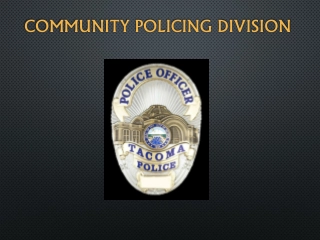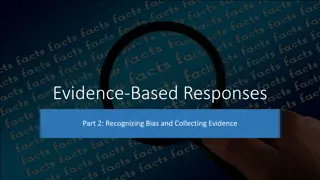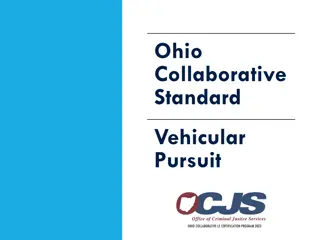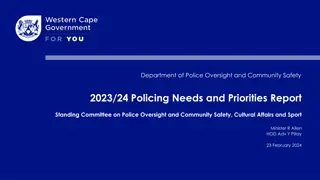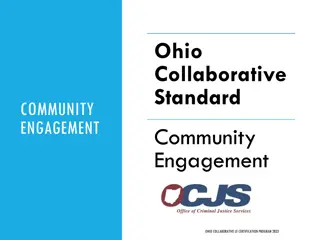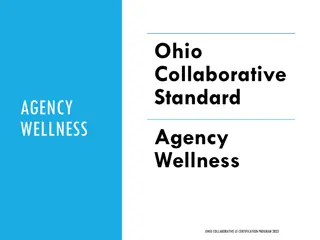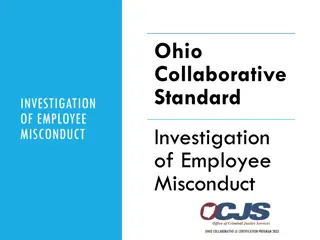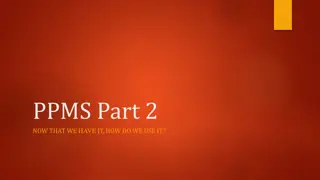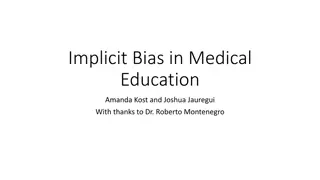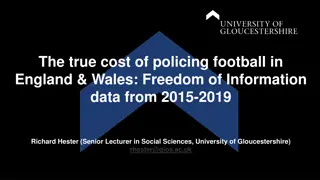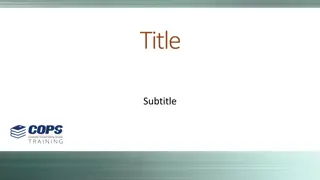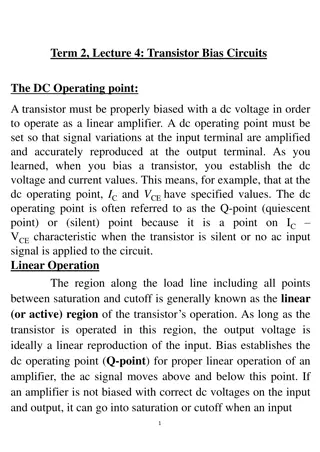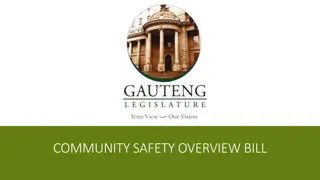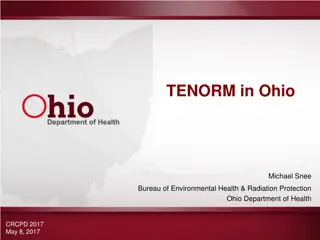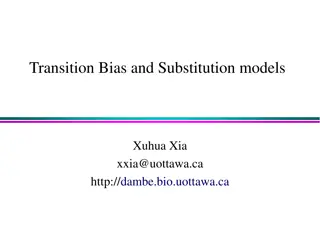Ohio Collaborative Standard Bias-Free Policing
Explore the Ohio Collaborative program for bias-free policing, focusing on maintaining public trust, transparency, and adherence to laws. Learn about the state's commitment to eliminating biased-based profiling and promoting responsible policing practices.
Download Presentation

Please find below an Image/Link to download the presentation.
The content on the website is provided AS IS for your information and personal use only. It may not be sold, licensed, or shared on other websites without obtaining consent from the author.If you encounter any issues during the download, it is possible that the publisher has removed the file from their server.
You are allowed to download the files provided on this website for personal or commercial use, subject to the condition that they are used lawfully. All files are the property of their respective owners.
The content on the website is provided AS IS for your information and personal use only. It may not be sold, licensed, or shared on other websites without obtaining consent from the author.
E N D
Presentation Transcript
Ohio Collaborative Standard Bias Free Policing OHIO COLLABORATIVE LE CERTIFICATION PROGRAM 2023
Standard for Bias Free Policing 5 Provisions for Bias Free Policing Potential issues with Biased Based Policing violations Learning Learning Objectives Objectives Definition of Bias Free Policing in Sample Policy Responsibility of agency employees in Sample Policy Ohio Collaborative annual review instructions Possible factors for the collection and review of data
Bias Free Policing Bias Free Policing To recognize always that the power of the police to fulfill their functions and duties is dependent on public approval of their existence, actions, and behavior, and on their ability to secure and maintain public respect. -Sir Robert Peel (1829)
Bias Free Policing Bias Free Policing 1.3.1 Action Item: To embrace a culture of transparency, law enforcement agencies should make all department policies available for public review and regularly post on the department s website information about stops, summonses, arrests, reported crime, and other law enforcement data aggregated by demographics. 21st Century Policing
Ohio Oath of Office Ohio Oath of Office I do solemnly swear or affirm that I will support the Constitution and Laws of the United States of America, the Constitution and Laws of the State of Ohio, and Laws and Ordinances of the political subdivision to which I am appointed and to the best of my ability will discharge the duties of this office.
Bias Free Policing Bias Free Policing In 2019, The Ohio Collaborative Community-Police Advisory Board adopted the state of Ohio Bias Free Policing.
Bias Free Policing Bias Free Policing Purpose: Law Enforcement agencies must prohibit the use of any bias- based profiling in its enforcement programs.
Bias Free Policing Bias Free Policing Standard: Agencies shall establish a written policy governing biased based profiling in traffic contacts, field contacts, and in asset seizure and forfeiture efforts.
Bias Free Policing Bias Free Policing Standard Provision #1: A prohibition against biased based profiling in traffic contacts, field contacts, and in asset seizures and forfeiture efforts.
Bias Free Policing Bias Free Policing Standard Provision #2: Training all agency enforcement personnel in biased based profiling issues and the relevant legal aspects.
Bias Free Policing Bias Free Policing Standard Provision #3: Corrective measures if biased based profiling occurs.
Bias Free Policing Bias Free Policing Standard Provision #4: The collection of data on all self-initiated traffic contacts to include, at a minimum, the race and gender of the driver of the vehicle stopped.
Bias Free Policing Bias Free Policing Standard Provision #5: A documented annual administrative review of agency practices, data collected, and citizen s concerns. This review shall be made available to the public.
Bias Free Policing Bias Free Policing Commentary: Officers shall not consider race/ethnicity to establish reasonable suspicion or probable cause. Officers may take in account the reported race/ethnicity of a potential suspect(s) based on trustworthy, locally relevant information that links a person or persons of a specific race/ethnicity to a particular unlawful incident(s).
Bias Free Policing Bias Free Policing Commentary (continued): Bias based profiling in enforcement programs may lead to: Constitutional rights violations Undermines legitimate law enforcement efforts Claims of civil rights violations Distrust by the community
Bias Free Policing Bias Free Policing Commentary (continued): Law enforcement personnel should focus on a person s conduct or other specific suspect information.
Bias Free Policing Bias Free Policing Commentary (continued): Annual agency profiling training in support of this standard should include: Field contacts Traffic stops Search issues
Bias Free Policing Bias Free Policing Annual agency profiling training (continued): Asset seizure and forfeiture Interview techniques Cultural Diversity Discrimination Community Support
Bias Free Policing Sample Policy Bias Free Policing Sample Policy Sample Policy Language Bias Free Policing Definition: The lack (absence) of inappropriate reliance on factors such as race, gender, gender identity, ethnicity, national origin, religion, sexual orientation, economic status, age, cultural group, disability or affiliation with any other similar identifiable group as a factor in deciding whether to take law enforcement action or to provide service.
Bias Free Policing Sample Policy Bias Free Policing Sample Policy Sample Policy Compliance Expectations Language: Policy: It shall be the policy of this agency to prohibit the use of bias- based profiling in its enforcement, or service programs. All members have a responsibility for achieving the department s goal of bias free services. Compliance Expectation Example: Agency Bias Free Policing policy.
Bias Free Policing Sample Policy Bias Free Policing Sample Policy Sample Policy Training and Compliance Expectations Language: Enforcement members of this agency shall receive training on biased based profiling issues and the relevant legal aspects. Compliance Expectation Example: Agency Bias Free Policing policy.
Bias Free Policing Sample Policy Bias Free Policing Sample Policy Sample Policy Training and Compliance Expectations Language: Training should include at a minimum, profiling related issues governing field contacts, traffic stops, search issues, asset seizures and forfeiture, interview techniques, cultural diversity, discrimination and community support. Compliance Expectation Examples: Training records, Power Point, read & sign, etc.
Bias Free Policing Sample Policy Bias Free Policing Sample Policy Sample Policy Language Corrective Measures: Corrective measures shall be used to address violations of this policy. Ex: based on other agency policies, standards of conduct, training, re-training, and/or progressive discipline process, etc.
Bias Free Policing Sample Policy Bias Free Policing Sample Policy Sample Policy Language Corrective Measures (continued): Ex: Supervisors shall monitor those individuals under their command for any behavior that may conflict with the purpose of this policy and shall handle any alleged or observed violation of this policy in accordance with the agencies disciplinary procedures. (a) Discussing possible violations in a timely manner. (b) Ensuring no retaliatory action against reporting member. Compliance Expectation Examples: Memorandum documenting the corrective actions needed, or not needed. (Redacted/No officer or complainant specifics)
Bias Free Policing Sample Policy Bias Free Policing Sample Policy Sample Policy Language Self-Initiated Collection of Data: Officers shall collect data regarding the race and gender of all self-initiated traffic stops. This information should be derived from the officer s observations, perceptions, or from known information services, i.e.; LEADS, OHLEG, CCH, or other known and trusted resources. Officers should not be required to request information about the race or gender of the contacted person. Compliance Expectation Examples: Demographics report of self-initiated traffic stops to include race and gender of the driver. Ex. Monthly, Quarterly or annual reports, Memorandum, annual review, any other method an agency uses to collect this data.
Bias Free Policing Sample Policy Bias Free Policing Sample Policy Sample Policy Language Annual Administrative Review: This agency will conduct a documented annual review of agency practices related to this policy, to include: agency practices, data collected and any citizen concerns related to this policy. This review shall be made available to the public.
Ohio Collaborative Annual Reviews Ohio Collaborative Annual Reviews Ohio Collaborative Annual Review Instructions: The intent of an annual review is to review the policy, and associated policies, to determine if any policy modifications should occur. Specific instructions will vary with each standard and should be included in the review. The general steps are: A. Review the policy, and associated policies, with this standard and determine if any policy modifications should occur. B. Use any data obtained to determine patterns and trends associated with this standard. C. Determine if there are any training needs in addition to those already required. D. Determine if there are any equipment needs or upgrades based on the review.
Ohio Collaborative Bias Free Ohio Collaborative Bias Free Policing Review Policing Review Possible factors to consider from conducting data collection and annual Bias Free Policing Review: Agencies have adopted the policy, employees understand the policy, training has been completed, little or no complaints have been received about officers and appropriate documentation for compliance has been completed. Traffic Stop (motorist) data/demographics are differing from the residential population of the particular jurisdiction.
Ohio Collaborative Bias Free Ohio Collaborative Bias Free Policing Review Policing Review Possible factors to consider from conducting data collection and annual Bias Free Policing Review (continued): It is important that agencies know all information about their public interactions. It is possible that the motorist population of a particular agency differs from the resident population of that jurisdiction.
Ohio Collaborative Bias Free Ohio Collaborative Bias Free Policing Review Policing Review Possible factors to consider from conducting data collection and annual Bias Free Policing Review (continued): Motorists travel through various jurisdictions for many reasons. Here are some: Entertainment Education Shopping Job opportunities in the jurisdiction or using it as a cut-through from home to work and vice-versa.
Ohio Collaborative Bias Free Ohio Collaborative Bias Free Policing Review Policing Review Possible factors to consider from conducting data collection and annual Bias Free Policing Review (continued): Agency s traffic violator statistics may be more of a representation of their surrounding area population as citizens travel in and through their jurisdiction.
Ohio Collaborative Bias Free Ohio Collaborative Bias Free Policing Review Policing Review Possible factors to consider from conducting data collection and annual Bias Free Policing Review (continued): Two possible ways of demonstrating traffic violator statistics (motorists) specific to a jurisdiction. 1. Tracking resident vs. non-resident on self-initiated traffic stops. 2. Tracking resident vs. non-resident of units involved in crashes.
Ohio Collaborative Bias Free Ohio Collaborative Bias Free Policing Review Policing Review Possible factors to consider from conducting data collection and annual Bias Free Policing Review (continued): Many Ohio agencies have conducted data collection for a long duration of time and are willing to help. OCJS s mission is to serve as the lead justice planning agency for the state of Ohio and will assist any agency.


